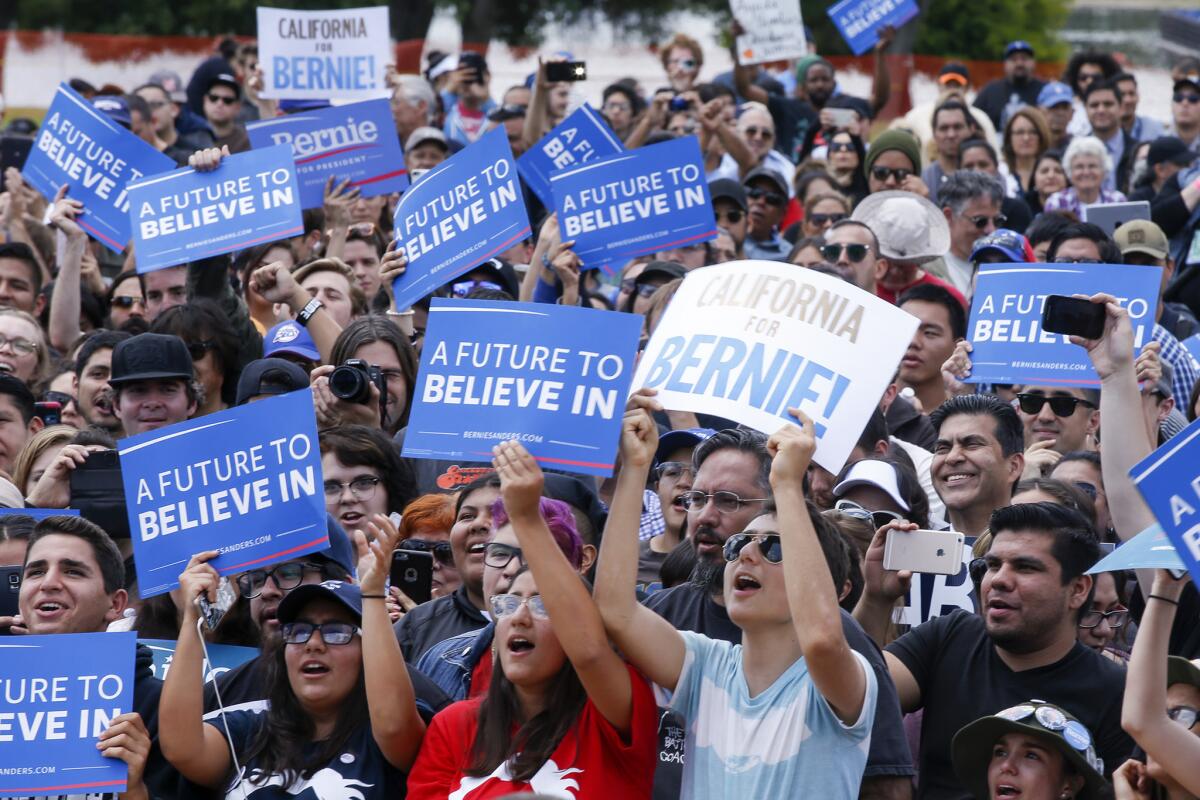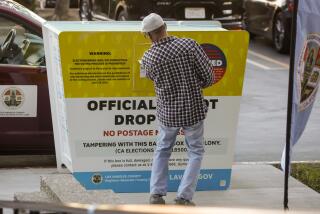Analysis: Hundreds of thousands of Californians have signed up to vote, but what that means is anybody’s guess

California, the state with a well-earned reputation for disinterest in things political, has been overrun by a vast and historic burst of new voters.
And those voters will storm the polling places, rescuing the state from its usual self-flagellation over poor turnout and determining the winner of the contested June 7 presidential primary.
Or it hasn’t. And they won’t.
The answers rely on two circumstances that were unclear as Monday’s deadline for registering to vote came and went. One is how voters are counted in this state. The other is whether those new voters, however large their cohort is, will defy tradition to show up.
Most state and local officials and voting experts believe that there has been a surge in new registrants. It’s just that it’s hard to prove it beyond a doubt. The numbers tend to confuse rather than clarify.
According to data from the office of Secretary of State Alex Padilla, hundreds of thousands of registrations occurred between mid-March and mid-May.
They show an increase of more than 220,000 Democrats, or a nearly 3-percentage-point boost in their numbers, which hit 7.7 million. Republican numbers rose by nearly 70,000, for a 1.45-percentage-point increase and a total of 4.8 million. And the ranks of non-partisan voters — which have been the fastest-growing in California for years now — actually fell by 20,000 to total 4.1 million, a drop of half a percentage point. None of that appears hugely significant.
But statistics kept by voting specialist Paul Mitchell suggest a far larger group has jumped into the pool.
By his count, more than 2 million fresh voters will be included by the time the tallies from Monday’s deadline are completed. According to counts made by his firm, Political Data Inc., there already has been a boost of 218% in Democratic registration, of 78% in Republican registration, and 74% in nonpartisan registrations.
Registrations among Latinos are up 123%, he said. Sign-ups among those 24 and younger are up 87% and those 25 to 30 are up 188%. The latter two categories would suggest a boost for Vermont Sen. Bernie Sanders.
The timing, however, is important. The figures compare the 2012 pre-primary period with 2016’s. In 2012, there was no Democratic primary because President Obama was seeking reelection. And since competition begets registration, disinterest in 2012 may have set up a more positive view of today’s registration.
Indeed, a comparison of official registration numbers shows the contested 2008 race had a bigger impact. Among Democrats, for example, more than 535,000 voters joined up in the four years before that election; the current gain over four years ago is just over 94,000.
Additionally, the numbers Mitchell’s firm collects include all manner of registrations, whether they come from voters who have never cast a ballot or those changing their party or address. So his figures probably overstate the actual number of new voters.
To know definitively how many new voters have registered, California would need to calculate the number of new registrants who have never taken part in an election, how many voters have been taken off the rolls for failing to vote and how the political alliances of the new voters square with the old voters. (A probable Sanders voter replacing another probable Sanders voter would be a net gain of zero.)
The state doesn’t know that.
Mitchell calls the current numbers “an historic surge in pre-primary registration — more akin to what we would have expected before a general election.” Purges of inactive voters, which are being applied by counties according to their own processes, serve to greatly underestimate the number of new voters in the secretary of state’s tabulations, he said.
Orange County recently dropped 108,000 voters who had not cast ballots in the last four state elections and had not replied to inquiries about their status, he said. So an increase of more than 100,000 new voters would leave the county basically stable under the state’s calculations.
“You have this real uneven implementation happening in huge waves at local counties,” Mitchell said.
Darry Sragow, a longtime Democratic strategist and publisher of the nonpartisan California Target Book, which assesses state races, took a more cautious view of California’s new voters.
“The net numbers that are being reported by the secretary of state do not shed light on what’s going on under the surface,” he said. “How many of the new registrants are first-time registrants and how do they differ from the significant number of voters who are being purged from the rolls?”
As for the impact, he said, it’s not clear if voters are registering to support a candidate or to vote against one — say, presumptive Republican nominee Donald Trump.
“To suggest a surge is only because of passion for Sanders — and there is passion — and overlook the fact that the notion of a Trump presidency is an awful thought to a lot of Democrats misses the point,” he said.
County officials confirm heightened interest this year.
By Friday, Los Angeles County had seen 196,000 new registrants, according to Dean Logan, the registrar-recorder/county clerk. Another 141,000 people had either changed their address or political party. Over the weekend, another 40,000 people registered, in both categories combined.
“That’s pretty phenomenal, more in comparison with what we’ve seen in the lead-up to a presidential general election,” Logan said.
The attraction of millennials to registering as independents — and the continued Democratic race — seem to have driven much of the action in the Los Angeles area. Both independents and Democrats can vote in the Democratic primary; only Republicans can take part in that party’s primary.
“The fact that Bernie Sanders and Hillary Clinton, regardless of delegates, still seem to be socking it out until the end — that continues to be a motivating impact,” Logan said.
Among the new registrants, more than 61% were under the age of 20. The second largest group of registrants in Los Angeles County was aged 30 to 39.
Though that suggests a Sanders vote, all manner of political entities are sponsoring voter registration drives this season, and the voters being drawn in could be more diverse than age alone suggests.
Latino organizations have sought to register voters in order to cast ballots against Trump. Candidates have their own voter drives.
Environmental activist Tom Steyer gave $688,000 to local and state Democratic groups for registration efforts in Los Angeles and seven other counties. He also gave $250,000 to the state Democratic Party for its registration programs. (Clinton is the Democratic favorite in pre-primary polls, while Sanders has the edge among independents).
At a recent Los Angeles forum on voting sponsored by the Public Policy Institute of California, Secretary of State Padilla said that, as elsewhere, the 2016 race is central to big registration numbers. That is particularly true in California, where the U.S. Senate race has been humdrum, and there is only one statewide measure on the June ballot.
“Obviously the presidential is driving a lot of energy, excitement and attention,” he said. The increase in registration online and in person-to-person contacts are “all signs of a public that’s paying attention and getting ready to turn out to vote.”
But will they?
Voting specialist Mitchell noted that so far early voting has not been dominated by the new voters. Percentage-wise, non-Latinos and voters over 55 have predominated.
It could be that young voters will catch up by June 7, or it could be that the act of registering was far more exciting than the reality of voting.
“It could be that there’s a little rush of cathartic exercise in registering and not a rush to actually pick among the 34 Senate candidates and ballot measures and I-don’t-know-who-my-congressman-is,” Mitchell said. “The voting isn’t as exciting as that moment when you see something on TV, horrific or exciting, and get your laptop and register to vote.”
Twitter: @cathleendecker. For more on politics, go to latimes.com/decker and subscribe to the free daily newsletter.
ALSO:
Sanders supporters sue to have voter registration deadline extended
California saw surge of new Democrats in first three months of 2016
California elections officials warn of ‘surge’ for June 7 primary
How California’s U.S. Senate ballot could cause confusion during the primary
Registered to vote at the DMV? Check again.
Updates on California politics
Live coverage from the campaign trail
More to Read
Get the L.A. Times Politics newsletter
Deeply reported insights into legislation, politics and policy from Sacramento, Washington and beyond. In your inbox three times per week.
You may occasionally receive promotional content from the Los Angeles Times.







